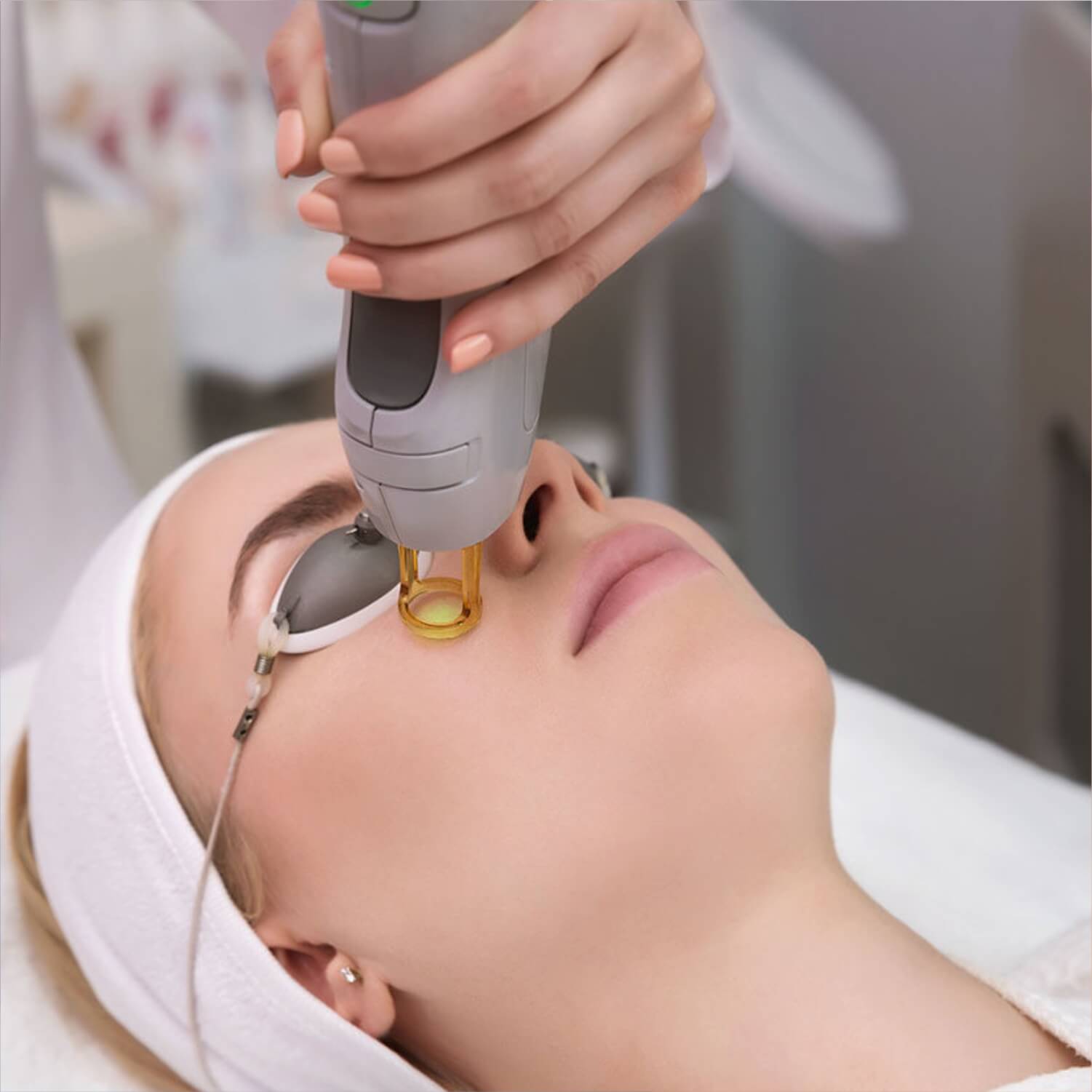Laser Skin Treatment in Navi Mumbai
Laser skin treatment uses focused light to improve skin appearance by targeting specific skin issues like wrinkles, scars, and hyperpigmentation. It stimulates collagen production, promoting smoother, rejuvenated skin. Common types include ablative lasers, which remove skin layers, and non-ablative lasers, which heat underlying tissue without damaging the surface. Results vary based on the condition treated, with minimal downtime for non-ablative treatments.
Laser skin treatment in Navi Mumbai at Niomi Aesthetic offers advanced solutions for various skin concerns. Utilizing modern technology, skilled dermatologists provide personalized treatments to address issues like acne scars, pigmentation, and signs of aging. With a focus on safety and efficacy, Niomi Aesthetic ensures patients receive professional care and achieve desired results, enhancing skin health and confidence.
Laser Skin Treatment Cost in Navi Mumbai
Laser skin treatments use focused light to rejuvenate skin, treating issues like wrinkles, scars, and pigmentation. Costs vary based on factors like treatment type, area size, and reputation. On average, prices range from INR 200 to INR 12000 per session.
Treatment Type | Price Range per Session (INR) |
Laser Hair Removal | 2,000 – 6,000 |
Laser Acne Treatment | 3,000 – 8,000 |
Laser Skin Rejuvenation | 4,000 – 10,000 |
Laser Scar Removal | 5,000 – 12,000 |
Note: Price may vary based on type of treatment.
Procedure of Laser Skin Treatment
A general procedure for laser skin treatment is presented below:
- Consultation: Before the procedure, you’ll have a consultation with a dermatologist or a trained specialist. They’ll assess your skin type, concerns, and medical history to determine if you’re a suitable candidate for laser treatment.
- Preparation: Before the treatment, your skin will be thoroughly cleansed to remove any makeup, oils, or debris. You may also be given protective eyewear to shield your eyes from the laser light.
- Numbing Cream (Optional): Depending on the type of laser treatment and your pain tolerance, a numbing cream may be applied to the treatment area to minimize discomfort during the procedure.
- Laser Application: During the treatment, the laser device will be precisely directed at the targeted areas of your skin. The laser emits controlled pulses of light energy, which are absorbed by the skin to address specific concerns such as wrinkles, scars, pigmentation, or unwanted hair. The duration of the procedure can vary depending on the size of the treatment area and the type of laser used.
- Cooling: Some laser devices have built-in cooling mechanisms to help minimize discomfort and protect the outer layers of the skin during treatment.
- Post-Treatment Care: After the procedure, your skin may appear red, swollen, or slightly irritated, similar to a sunburn. Your provider may apply soothing creams or cold packs to alleviate any discomfort. It’s essential to follow their specific post-treatment instructions, which may include avoiding sun exposure, wearing sunscreen, and using gentle skincare products.
- Follow-Up: Depending on your skin concerns and the recommended treatment plan, you may require multiple sessions spaced several weeks apart to achieve optimal results. Your provider will schedule follow-up appointments to assess your progress and adjust the treatment as needed.
- Long-Term Maintenance: To maintain the results of your laser treatment, it’s essential to follow a skincare regimen recommended by your provider, protect your skin from sun damage, and avoid behaviors that can accelerate skin aging, such as smoking and excessive sun exposure.
Types of Laser Skin Treatment
There are several types of laser skin treatments, each designed to address specific skin concerns and conditions.
- Fractional Laser Resurfacing: The goal is to stimulate collagen production, and improve texture, tone, and pigmentation irregularities by targeting small areas in the skin with microscopic laser columns.
- Carbon Dioxide (CO2) Laser Therapy: CO2 lasers are ablative, meaning they remove thin layers of skin to treat wrinkles, scars, and other skin imperfections. They are often used for more severe cases of aging or scarring.
- Erbium Laser Resurfacing: A less aggressive Erbium laser is generally used for mild to moderate wrinkles, lines, and pigmented lesions when compared to a Co2 laser. Erbium laser also helps in removing acne scars.
- Q-Switched Laser Therapy: This form of laser is extensively used in a tattoo removal process and treatment for pigmentation abnormalities such as liver spots, freckles, or melasma. Operating on the principle of disintegrating pigmented lesions into smaller particles that can be absorbed by the body.
- Pulsed-Dye Laser (PDL): PDL emits yellow light that targets blood vessels in the skin. It’s effective for treating vascular conditions like rosacea, spider veins, and port-wine stains.
- ND Laser: This laser can penetrate deeper layers of the skin and is often used for hair removal, treating vascular lesions, and tightening sagging skin.
- Intense Pulsed Light (IPL) Therapy: While technically not a laser, IPL uses broad-spectrum light to target various skin concerns like sun damage, rosacea, and hyperpigmentation.
- Fractional Radiofrequency (RF) Microneedling: Combining microneedling with RF energy, this treatment stimulates collagen production and improves skin texture, tone, and laxity.
- Non-Ablative Laser Therapy: The lower layers of the skin are targeted by these laser beams without affecting the top layer of the skin. They trigger the production of collagen and address mild to moderate wrinkles, scars, and irregular pigmentation.
Benefits of Laser Skin Treatment
- Improved Skin Texture: Laser treatments can help improve skin texture by stimulating collagen production, which can reduce the appearance of fine lines, wrinkles, and acne scars.
- Even Skin Tone: Laser therapy can target areas of hyperpigmentation or uneven skin tone, helping to break up excess melanin and reveal a more even complexion.
- Reduced Signs of Aging: By promoting collagen regeneration, laser treatments can minimize the appearance of wrinkles, crow’s feet, and other signs of aging, resulting in smoother, more youthful-looking skin.
- Treats Various Skin Conditions: Laser therapy is versatile and can effectively treat a range of skin conditions, including acne, rosacea, sun damage, and vascular lesions, providing comprehensive skincare solutions.
- Minimal Downtime and Side Effects: Many laser skin treatments require minimal downtime and have few side effects compared to more invasive procedures, making them convenient options for busy individuals seeking noticeable improvements in their skin’s appearance.

Frequently Asked Questions
Laser treatment can address a variety of skin concerns, including but not limited to:
- Acne scars
- Fine lines and wrinkles
- Sun damage
- Age spots and pigmentation irregularities
- Rosacea
- Uneven skin texture
- Tattoo removal
- Hair removal
Laser skin treatment works by delivering concentrated beams of light to specific areas of the skin. The light energy is absorbed by targeted cells, which stimulates collagen production, reduces pigmentation, or destroys unwanted cells (such as hair follicles). Different techniques include:
- Fractional laser resurfacing
- Non-ablative laser therapy
- Ablative laser therapy
- Intense pulsed light (IPL) therapy
provided by your skincare professional.
The typical recovery time after a laser skin treatment session varies depending on the type of treatment and the individual's skin sensitivity. Generally, mild redness, swelling, and sensitivity may occur immediately after treatment and usually subside within a few days to a week. More intense treatments may require longer downtime.
While laser skin treatment is generally considered safe when performed by a qualified practitioner, there are potential risks and side effects, including:
- Temporary discomfort during treatment
- Redness, swelling, or blistering
- Changes in skin pigmentation (hyperpigmentation or hypopigmentation)
- Scarring (rare)
- Infection (rare)
- Reactivation of herpes cold sores (with certain types of treatments).
Different individuals require different amounts of time before achieving the best possible laser treatment outcome. The main things that determine how many times each person needs to have a session include his/her skin problems; the kind of laser used on him/her as well as what one needs to get from the treatment. In most cases, people will need more than one session spaced out over about 3 weeks to have good outcomes (benefits). For example, someone may need 6-8 sessions for hair removal and 1-3 sessions for skin resurfacing. While some results last for months up to years, it may be important to engage in maintenance treatments so that they’re sustained.
